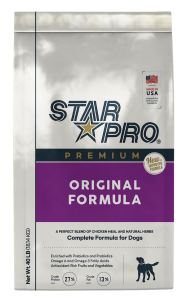
DogFoodAdvisor is reader supported See how
All reviews are 100% impartial but if you buy using links on this page, we may earn a referral fee.
Star Pro Dog Food receives the Advisor’s second-lowest tier rating of 2.5 stars.
The Star Pro Dog Food product line includes the 6 dry dog foods listed below.
Each recipe includes its related AAFCO nutrient profile when available on the product’s official webpage: Growth, Maintenance, All Life Stages, Supplemental or Unspecified.
- Star Pro Puppy Formula (3.5 stars) [A]
- Star Pro Original Formula (2.5 stars) [A]
- Star Pro Professional Formula (2 stars) [A]
- Star Pro High Energy Formula (2 stars) [A]
- Star Pro Maintenance Formula (2 stars) [M]
- Star Pro Performance Formula (3.5 stars) [A]
Recipe and Label Analysis
Star Pro Original Formula was selected to represent the other products in the line for this review.
Star Pro Original Formula
Estimated Dry Matter Nutrient Content
Protein
Fat
CarbsCarbohydrates
Chicken by-product meal (natural source of glucosamine & chondroitin sulfate), ground yellow corn, ground whole wheat, meat and bone meal, chicken fat (preserved with mixed tocopherols), dried plain beet pulp, brewers rice, corn gluten meal, fish meal, flaxseed, natural flavor, salt, dicalcium phosphate, potassium chloride, fish oil (source of DHA), choline chloride, vitamin A supplement, vitamin D3 supplement, vitamin E supplement, vitamin B12 supplement, riboflavin supplement, dl-methionine, niacin, calcium pantothenate, menadione sodium bisulfite complex (source of vitamin K activity), folic acid, biotin, thiamine mononitrate, pyridoxine hydrochloride, sodium selenite, calcium iodate, ferrous sulfate, manganese sulfate, zinc sulfate, copper sulfate
Fiber (estimated dry matter content) = 3.5%
Red denotes any controversial items
| Estimated Nutrient Content | |||
|---|---|---|---|
| Method | Protein | Fat | Carbs |
| Guaranteed Analysis | 27% | 12% | NA |
| Dry Matter Basis | 30% | 13% | 49% |
| Calorie Weighted Basis | 27% | 29% | 44% |
Ingredient Analysis
The first ingredient in this dog food is chicken by-product meal, a dry rendered product of slaughterhouse waste. It’s made from what’s left of a slaughtered chicken after all the choice cuts have been removed.
In addition to organs, this item can also include feet, beaks, undeveloped eggs and almost anything other than prime skeletal muscle.
On the brighter side, by-product meals are meat concentrates and contain nearly 300% more protein than fresh chicken.
The quality of this ingredient can vary, depending on the caliber of the raw materials obtained by the manufacturer.
The second ingredient is corn. Corn is an inexpensive and controversial cereal grain. And aside from its energy content, this grain is of only modest nutritional value to a dog.
For this reason, we do not consider corn a preferred component in any dog food.
The third ingredient is wheat. Wheat is another cereal grain and subject to the same issues as corn (previously discussed).
The fourth ingredient is meat and bone meal, a dry “rendered product from mammal tissues, including bone, exclusive of any added blood, hair, hoof, horn, hide trimmings, manure, stomach and rumen contents”.1
Meat and bone meal can have a lower digestibility than most other meat meals.
Scientists believe this decreased absorption may be due to the ingredient’s higher ash and lower essential amino acid content.2
What’s worse, this particular item is anonymous. So, the meat itself can come from any combination of cattle, pigs, sheep or goats — which can make identifying specific food allergens impossible.
Even though meat and bone meals are still considered protein-rich meat concentrates, we do not consider a generic ingredient like this to be a quality item.
The fifth ingredient is chicken fat. Chicken fat is obtained from rendering chicken, a process similar to making soup in which the fat itself is skimmed from the surface of the liquid.
Chicken fat is high in linoleic acid, an omega-6 fatty acid essential for life. Although it doesn’t sound very appetizing, chicken fat is actually a quality ingredient.
The sixth ingredient is beet pulp. Beet pulp is a controversial ingredient, a high fiber by-product of sugar beet processing.
Some denounce beet pulp as an inexpensive filler while others cite its outstanding intestinal health and blood sugar benefits.
We only call your attention here to the controversy and believe the inclusion of beet pulp in reasonable amounts in most dog foods is entirely acceptable.
The seventh ingredient includes brewers rice. Brewers rice is a cereal grain by-product consisting of the small fragments left over after milling whole rice. Aside from the caloric energy it contains, this item is of only modest nutritional value to a dog.
The eighth ingredient is corn gluten meal. Gluten is the rubbery residue remaining once corn has had most of its starchy carbohydrate washed out of it.
Although corn gluten meal contains 60% protein, this ingredient would be expected to have a lower biological value than meat.
And less costly plant-based products like this can notably boost the total protein reported on the label – a factor that must be considered when judging the actual meat content of this dog food.
The ninth ingredient is fish meal, another protein-rich meat concentrate.
Fish meal is typically obtained from the “clean, dried, ground tissue of undecomposed whole fish and fish cuttings” of commercial fish operations.3
Unfortunately, this particular item is anonymous. Because various fish contain different types of fats, we would have preferred to have known the source species.
From here, the list goes on to include a number of other items.
But to be realistic, ingredients located this far down the list (other than nutritional supplements) are not likely to affect the overall rating of this product.
With 5 notable exceptions…
First, we find flaxseed, one of the best plant sources of healthy omega-3 fatty acids. Provided they’ve first been ground into a meal, flax seeds are also rich in soluble fiber.
However, flaxseed contains about 19% protein, a factor that must be considered when judging the actual meat content of this dog food.
Next, fish oil is naturally rich in the prized EPA and DHA type of omega-3 fatty acids. These two high quality fats boast the highest bio-availability to dogs and humans.
Depending on its level of freshness and purity, fish oil should be considered a commendable addition.
Additionally, we find no mention of probiotics, friendly bacteria applied to the surface of the kibble after processing to help with digestion.
We also note the minerals listed here do not appear to be chelated. And that can make them more difficult to absorb. Chelated minerals are usually associated with higher quality dog foods.
And lastly, this food contains menadione, a controversial form of vitamin K linked to liver toxicity, allergies and the abnormal break-down of red blood cells.
Since vitamin K isn’t required by AAFCO in either of its dog food nutrient profiles, we question the use of this substance in any canine formulation.
Star Pro Dog Food Review
Judging by its ingredients alone, Star Pro Dog Food looks like a below-average dry product.
The dashboard displays a dry matter protein reading of 30%, a fat level of 13% and estimated carbohydrates of about 49%.
As a group, the brand features an average protein content of 29% and a mean fat level of 18%. Together, these figures suggest a carbohydrate content of 45% for the overall product line.
And a fat-to-protein ratio of about 63%.
Near-average protein. Above-average fat. And below-average carbs when compared to a typical dry dog food.
Even when you consider the protein-boosting effect of the corn gluten meal and flaxseed, this looks like the profile of a kibble containing a moderate amount of meat.
Bottom line?
Star Pro is a grain-inclusive dry dog food using a moderate amount of named and unnamed by-product meals as its main source of animal protein, thus earning the brand 2.5 stars.
Not recommended.
Star Pro Dog Food Recall History
The following list (if present) includes all dog food recalls since 2009 directly related to this Star Pro product line. If there are no recalls listed in this section, we have not yet reported any events.
You can view a complete list of all dog food recalls sorted by date. Or view the same list sorted alphabetically by brand.
Notes and Updates
Compare This Dog Food
How does this brand compare with The Dog Food Advisor's most recommended brands?
Sources
A Final Word
The Dog Food Advisor does not accept money, gifts, samples or other incentives in exchange for special consideration in preparing our reviews.
However, we do receive a referral fee from online retailers (like Chewy or Amazon) and from sellers of perishable pet food when readers click over to their websites from ours. This helps cover the cost of operation of our free blog. Thanks for your support.
For more information, please visit our Disclaimer and Disclosure page.









